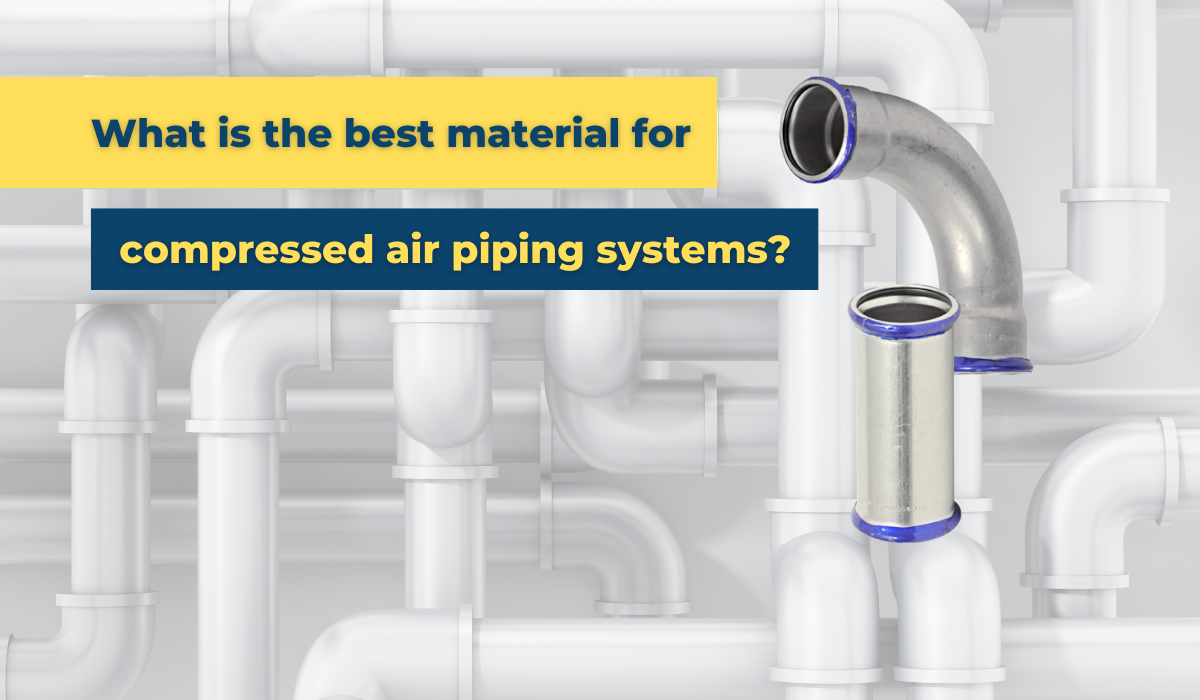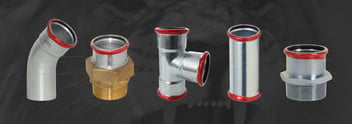What is the best material for compressed air piping systems?
Compressed air is a vital utility used in a wide range of applications. Pipework is an essential component of any compressed air system, designed to carry compressed air to its point of use. The question is, which material is right for your compressed air pipes?
In this article, we outline the key details of each piping material used in compressed air systems. We explain which materials are safest and most reliable so you can ensure your system operates as efficiently as possible.
Common compressed air piping materials
Depending on your application and the environmental conditions your system will operate in, different piping materials may be more appropriate. Below, we have highlighted the key pros and cons of the common materials used in compressed air piping.
Polyethylene (PE)
PE is a type of thermoplastic material which can be extruded in a wide range of sizes, from 13mm to 2000mm in diameter. The pros and cons of PE for compressed air piping are as follows:
Pros of PE piping
-
Low cost
-
Corrosion resistant
-
Flexible
-
The smooth bore improves system performance
Cons of PE piping
-
Thermal expansion and contraction can create movement and look untidy
-
Heavy pipe walls can mean you have a reduced bore or need to install a larger pipe to maintain appropriate bore size
In PE piping systems, compression fittings are suited to low-pressure systems. For medium-pressure systems, opt for socket fusion or electro-fusion fittings.
It is recommended to use PE pipe with a pressure rating at least 50% above maximum system pressure.
Nylon tubing
Nylon tubing is made from polyamide resin, which has a strong resistance to abrasion. It is often used in high-pressure and high-temperature applications.
Pros of nylon tubing
-
Fast installation using push-fit technology
-
Easy to make system adjustments
-
Corrosion resistant
Cons of nylon tubing
-
Limited sizes
Aluminium piping
Lightweight and malleable, aluminium is a popular choice for piping applications. One thing to note is that it can be susceptible to electrolysis if the coating is damaged.
Pros of aluminium piping
-
Lightweight
-
Fast and easy installation
-
Minimal expansion or contraction
-
Tidy appearance
Cons of aluminium piping
-
Susceptible to electrolysis if the coating is damaged
Black steel
Black steel pipes are made of steel and without a coating such as zinc - the dark colour is formed by iron oxide throughout the production process. It has high strength and durability but does require heavier duty bracketing due to its weight.
Pros of black steel piping
-
High strength
-
Durable
-
Can withstand high pressure
Cons of black steel piping
-
Slow installation
-
Requires heavier duty bracketing and support due to increased weight
-
Susceptible to corrosion if moisture and air combine
The most common jointing methods for black steel are welded or threaded connections.
Galvanised steel
Galvanised steel is one of the most popular types of steel because of its durability, strength, and formability. The zinc coating also helps to protect the base metal by acting as a barrier to corrosive elements.
Pros of galvanised steel piping
-
High strength
-
Durable
-
Can withstand high pressure
Cons of galvanised steel piping
-
The zinc coating could flake and cause system blockages which pose a safety risk
-
Requires heavier duty bracketing and support
In galvanised pipe systems, threaded connections are the most common.
Stainless steel
Stainless steel is a blend of corrosion-resistant alloys containing a minimum of 10.5% chromium. Compared to mild steel, it is a harder metal with high resistance to erosion.
Pros of stainless steel piping
-
Durable
-
Corrosion-resistant
-
Fast installation with press-fit and compression jointing methods
-
Can withstand high pressure
Cons of stainless steel piping
-
Higher material costs
Stainless steel jointing methods include welding, threaded, press-fit, and twin ferrule compression. For low to medium pressure systems, threaded and press-fit joins are preferred. For high pressure systems, use welded or twin ferrule joins.
Copper
Copper is a soft, malleable, and ductile metal with extremely high thermal and electrical conductivity. When freshly exposed, the surface of pure copper has a pinkish-orange tone.
Pros of copper piping
-
Malleable and easy to work with
-
Corrosion-resistant
-
Lightweight
Cons of copper piping
-
Easily damaged if knocked
Common jointing methods for copper tubing include brazing and press-fit connections.
Is PVC safe for compressed air piping?
We often get asked if PVC is suitable for compressed air systems and while it is cost-effective, it is not recommended. This is because the structural integrity of PVC can be weakened by oils and lubricants that may be present, potentially causing system failure and posing a safety risk.
There are much safer and more durable piping options on the market that can be used for compressed air systems, like those mentioned above.
How to choose piping material for your compressed air system
When choosing which piping material is most suitable for your compressed air system, there are several defining factors to take into account.
Pipe size
For compressed air systems, you need to select the right piping size to meet air demand. This will affect the efficiency, economics, performance, and longevity of your entire system. To determine which pipe size is correct, you need to identify air demand, flow rate, pressure, length of pipeline, and peak demand.
Pressure
For compressed air piping, you must consider a jointing method based on the system’s operating pressure. For low-pressure systems, PE or nylon can be used with a mechanical compression jointing method.
Medium to high-pressure systems may require stronger pipes made of black steel or stainless steel. Additionally, you may need to incorporate welded or twin-ferrule compression systems like Vis-Lok.
Environmental conditions
When choosing piping materials for a compressed air system, you need to consider the installation environment. For corrosive marine or coastal areas, a stainless steel solution will be most effective. For a clean, dry, non-corrosive environment such as a workshop, PE or aluminium will usually suffice.
Safety
System safety is critical in compressed air systems due to the risks of high-pressure system failure. To prevent this, you should always make sure the piping system specifications exceed operating system requirements. Consider the worst-case scenario when reviewing operating system specifications and allow a reasonable safety margin.
Cost vs suitability
How does the cost of your piping material compare to its suitability for the system? You may not want to install a higher-priced system when there's a suitable cost-effective solution available. However, you should always avoid compromising safety or longevity for cost savings.
Installation costs
Some systems have high material costs but fast installation times, often resulting in lower completed system costs. For example, the components for press-fit and mechanical compression systems may cost more but they are much quicker to install.
On the other hand, welded systems typically have lower component costs and higher installation costs. Depending on your system size and requirements, you can decide which piping system is right for you.
Common mistakes to avoid when installing compressed air piping
In our many years in the industry, we’ve heard plenty of stories about system failures and poor design. To avoid these situations, we’ve outlined our top design and installation tips below:
-
Check the system pressure requirements
-
Allow appropriate drain points
-
Use the correct bracketing systems to prevent pipework movement
-
Use the correct pipe size
If in doubt, reach out to our expert team at Waterworks. We’ve designed and installed pipework for a wide range of applications, including compressed air systems.
For further information on the best piping material for compressed air applications, check out our piping systems such as Europress or reach out to our team today.




.png?width=352&name=Waterworks%20%20Europress%20compressed%20air%20email%20graphic%20(1).png)
-1.png?width=352&name=Copy%20of%20WW%20%20Blog%20headers%202023%20(1)-1.png)